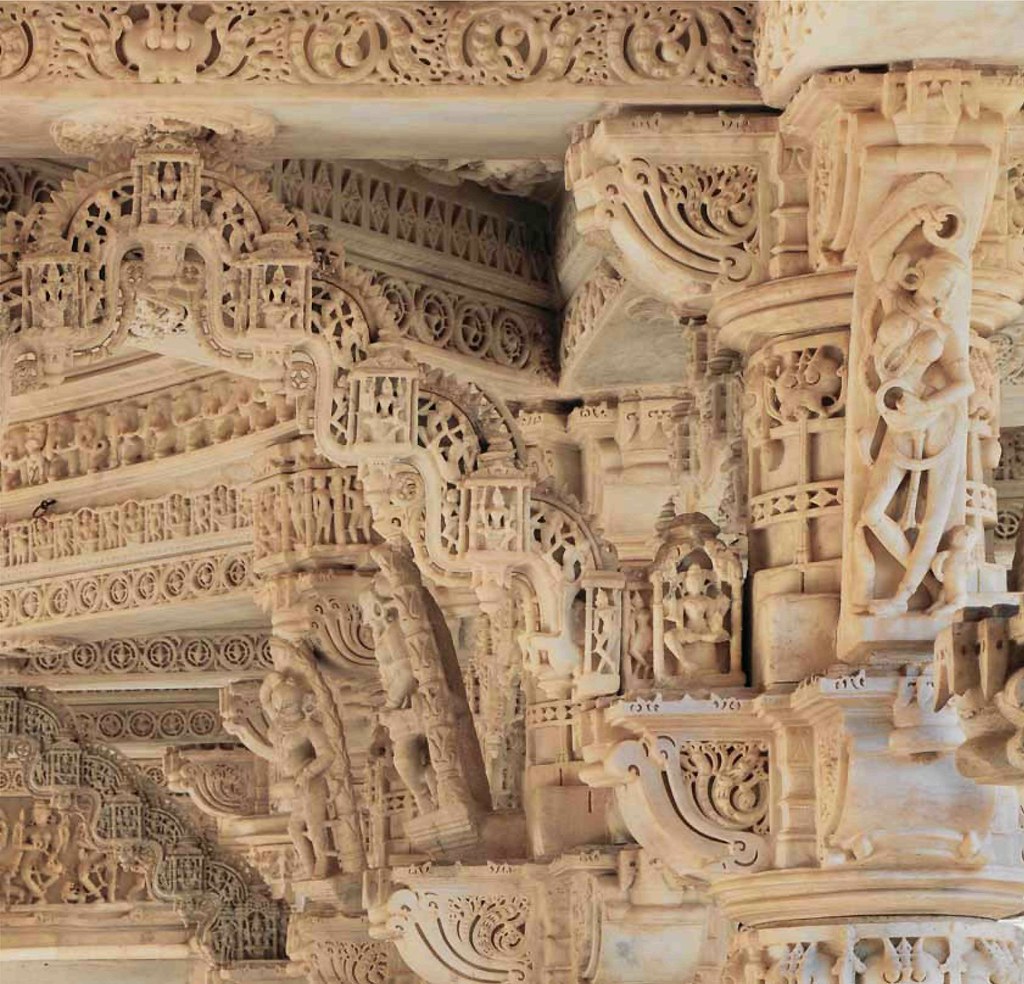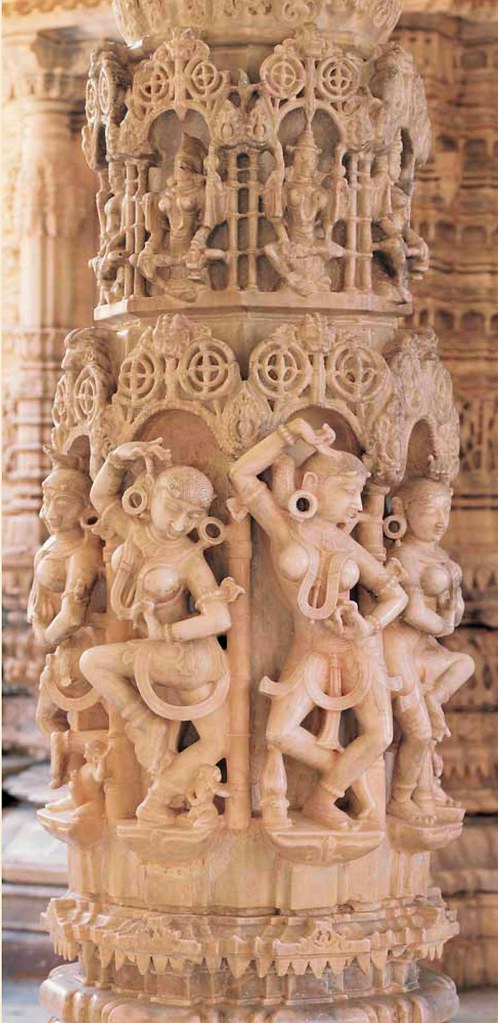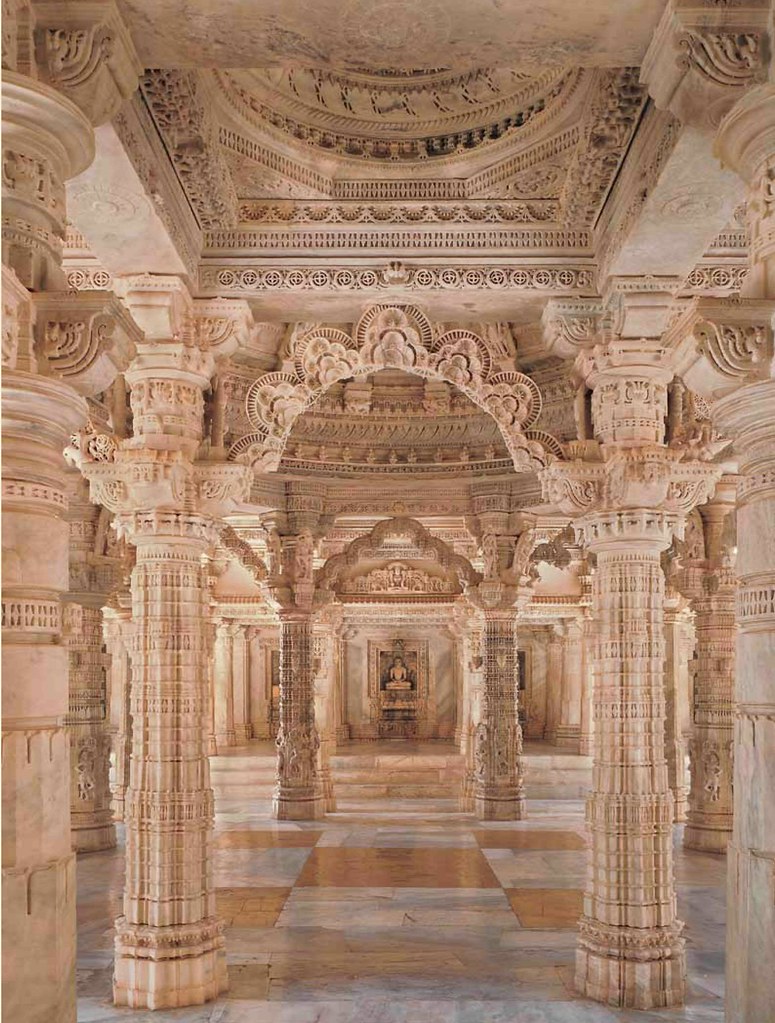 Toranas in the ranga-mandapa of Luna Vasahi /Tejapala Temple, left
Toranas in the ranga-mandapa of Luna Vasahi /Tejapala Temple, left Toranas in the ranga-mandapa of Luna Vasahi /Tejapala Temple, right
Toranas in the ranga-mandapa of Luna Vasahi /Tejapala Temple, rightThe name Abu derived from Arbudachala (Arhuda’s hill), alludes to the genesis of the mountain. Long ago, the sage Vasishta, Rama’s teacher, is supposed to have lived here; even the national epic, the Mahabharata, whose origin dates back to centuries before the birth of Christ, mentions the place as Vasishtashram (home of Vasishta). The saintly hermit possessed a magical cow. Kamadhenu (cow of abundance), which could fulfil any wish an Indian version of Grimm’s fairytale ‘The Table, the Ass and the Stick’. One day the cow fell into a big lake and the sage appealed to the gods in the Himalayas for help. The gods sent down the serpent Arbuda who filled up the lake with an enormous rock, namely Mt. Abu and thus helped the cow to reach safety and land again.
 Pillar of the navchoki with female dancers in Luna Vasahi / Tejapala Temple
Pillar of the navchoki with female dancers in Luna Vasahi / Tejapala Temple
Pillar of the navchoki with female dancers in Luna Vasahi / Tejapala Temple
According to another legend, this again has Vasishta as its central figure. Abu is one of the original holy places leading to the creation of Rajasthan or at least to the creation of the most important Rajput clans. When Vishnu dwelt on earth in his sixth incarnation as Parashurama, he systematically exterminated the warrior caste, the Kshatriyas, with his Famous axe. The other gods sought the assistance of Vasishta to maintain the necessary balance within society. The sage then performed the ancient magic fire ritual in his hermitage and from the flames; he brought forth the four clans of Rajput, born of fire. These were the Pratihara, Chauhan, Solanki and Parmar, ever since these clans have played a crucial role in shaping the history of Rajasthan. Even the royal families of Jaipur and Udaipur claim descent from them.
The character of Parashurama provides a mythological explanation for the super cession of the warrior class by the Brahmans following the Aryan invasion. The Kshatriyas had been the dominant class up to that time. At the same time, this story also illustrates how it was possible for the warrior class lo retain its privileged position in Rajasthan. Perhaps the story also provides an insight into the conversion of the former Huns from Central Asia to the Rajput clans by initiation through fire. The Rajput clans were regarded as sacrosanct. Even today, visitors are taken ten kilometres outside the city to view the hermitage of Vasishta and the place where he performed the fire ritual.
 View through toranas surrounding the ranga-mandapa onto the Sanctum in Vimala Vasahi Temple
View through toranas surrounding the ranga-mandapa onto the Sanctum in Vimala Vasahi TempleThe Parmars, who ruled over Abu from the 10th to the 14th centuries, probably belonged to this area. This fact is supposed to corroborate a variation of the legend narrated above: in this case, a certain Vishwamitra stole Vasishta’s cow. Because of this theft, the sage lit the holy fire, made sacrificial offerings and recited sacred texts until a gigantic hero leapt out of the flames, this hero then brought back the cow. Whereupon the grateful sage gave him name of Parmar (slayer of the enemy). Since this story has come down to us from Padmagupta Parimala at the end of the 10th century, it is possible it was fabricated to justify the Parmar rule that had just then been established. The clan is known to have existed historically since the beginning of the 9th century. At that time they were still the vassals of the Rashtrakutas in the Deccan.
Since ancient times, therefore the Hindus as well as the Jains have regarded Abu as holy. The son of Adinatha, the first Tirthankara, believed to have built a temple dedicated to his father in a place named the court of the gods. Later Mahavira came to Mt. Abu in search of enlightenment and, in emulating him, followed hundreds of thousands of Jains. Through the years, they came to do penance and to advance on the path of moksha.
